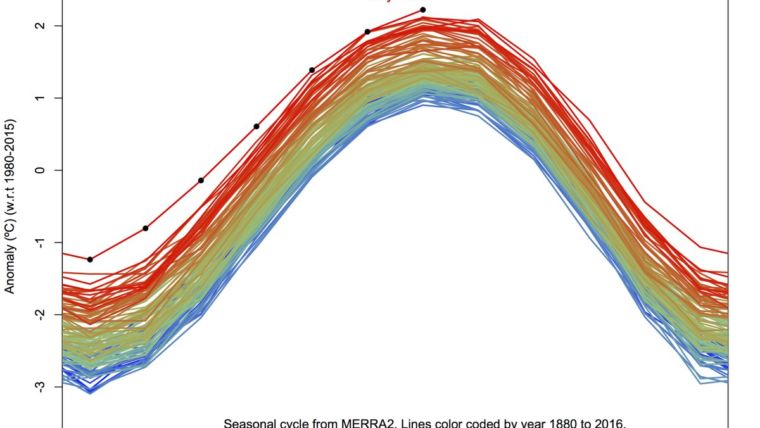Before I get to the topic of this article, I want to recognize that we are still in the grip of a terrible pandemic and that, in my humble opinion, we are not “over it” as some might have you believe. Based on the chaos and lack of a coherent plan to tame this beast it appears to me that the worst is yet to come and that we have a long road to any level of safety and normalcy ahead of us. Due to the orders to stay at home, a relative of mine brought to my attention that blood banks are suffering terribly and need donations. Thus, if it’s at all possible I hope you’ll considering finding a location and volunteer to give. Thanks for your consideration.
Now, on to the subject matter. It’s been a while since I’ve written about the data relating to what are the actual consequences that our planet is experiencing due to the climate’s warmer temperatures. The following article from March reiterates two important items.
1. Ice sheets all over the planet are continuing to melt at alarming rates and raising sea levels.
2. That new and improved monitoring and forecasting models are confirming and reiterating previous data.
Relating to item #1 above:
“Greenland’s unusually mild summer in 2019 caused the world’s largest island to lose 600 billion tons of ice in just two months, rivaling the summer of 2012 for the most ice mass lost in a single melt season, according to NASA data released Wednesday.
We knew this past summer had been particularly warm in Greenland, melting every corner of the ice sheet, but the numbers are enormous…
The mass loss from Greenland alone was enough to raise global sea levels by 2.2 millimeters, the study found.”
“This extends the satellite-based ice mass loss record to 17 years, beginning in March 2002 and including a minor gap in data sets.”
“study finds Greenland lost 4,550 billion tons of ice, or an average of about 261 billion tons per year.”
Relating to the second item above, the new data is from a new satellite mission that confirms that of the previous mission, now with improved technology, that confirms that the data upon which previous forecasts were based is reliable.
““What the study shows is that we have a very consistent data set between the two satellite missions,” Velicogna said.
“This is the science community having a big sigh of relief,”…
The relief isn’t because Greenland is melting, Willis said, but rather because “our tool for measuring it is working.””
The Washington Post
Greenland Lost a Near-record 600 Billion Tons of Ice Last Summer, Raising Sea Levels

An Arctic researcher sets out to retrieve oceanographic moorings and a weather station over meltwater topping sea ice in northwest Greenland during the 2019 melt season. (Steffen Olsen)
Greenland’s unusually mild summer in 2019 caused the world’s largest island to lose 600 billion tons of ice in just two months, rivaling the summer of 2012 for the most ice mass lost in a single melt season, according to NASA data released Wednesday.
“We knew this past summer had been particularly warm in Greenland, melting every corner of the ice sheet, but the numbers are enormous,” said lead author Isabella Velicogna, an Earth science professor at the University of California at Irvine and a senior scientist at NASA’s Jet Propulsion Laboratory, in a news release.
The mass loss from Greenland alone was enough to raise global sea levels by 2.2 millimeters, the study found.
Study confirms new satellite mission is working
The data, published in the journal Geophysical Research Letters, also find measurements from a new satellite system, known as the Gravity Recovery and Climate Experiment Follow-On mission (GRACE-FO), are consistent with the previous incarnation of gravity-sensing satellites, known simply as GRACE, which went out of service in 2017. This extends the satellite-based ice mass loss record to 17 years, beginning in March 2002 and including a minor gap in data sets.
The GRACE-FO satellites are able to sense tiny changes in Earth’s gravitational field caused by ice sheets gaining or losing mass and have proved useful in studying groundwater storage worldwide.
Between 2002 and 2019, across the full time series of both satellite missions, the study finds Greenland lost 4,550 billion tons of ice, or an average of about 261 billion tons per year.
In an interview, Velicogna said the data clearly show 2019 was a major melt year in Greenland, and what distinguishes it from previous big ice-loss years is the significant melting that occurred in glaciers in the northern and northeastern regions.
“There is a significant [melt] component also coming from the north and northeast of Greenland. And so, basically, we have the loss all around the ice sheet,” she said.
Yara Mohajerani, a study co-author from UC Irvine, said persistent high-pressure areas, as well as low cloud cover in northern Greenland, caused ice losses there to spike last year.
The study also examines ice loss in Antarctica, finding while ice loss continues in the Antarctic Peninsula and western Antarctica, including the Amundsen Sea Embayment, there was a mass gain from increased snowfall in a part of East Antarctica known as Queen Maud Land.
Robin Bell, an expert on ice sheet dynamics at Columbia University who was not involved in the study, said the study is valuable for researchers seeking to narrow their estimates of future sea-level rise.
“This is a beautiful update of how we can really see how the ice sheets are changing … from the annual inhale and exhale as the snow accumulates in the winter in Greenland and melts in the summer,” she said.
“This is also a nice stitching together of the two pairs of satellites from different groups that all tell the same story for both ice sheets. Fascinating the increased mass in East Antarctica indicating more snowfall that is buffering the impact of the faster-flowing ice in west Antarctica.”
The study shows for the first time the GRACE-FO data accurately capturing the same ice sheet dynamics as the previous GRACE satellites did, which is a relief for scientists who depend on this information and were hoping there were no major gaps or inconsistencies between the records.
Typically, a new satellite mission will overlap with the old one to iron out any discrepancies, but in this case, the GRACE-FO satellites weren’t ready to be launched until after the previous generation of satellites went out of service.
“What the study shows is that we have a very consistent data set between the two satellite missions,” Velicogna said.
“This is the science community having a big sigh of relief,” said Josh Willis, a climate researcher at NASA JPL who was not involved in the study.



